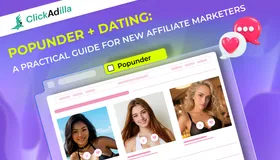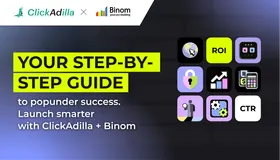
Learn how to run profitable webcam ad campaigns with ClickAdilla. This guide covers the best traffic sources, ad formats, and optimization strategies to maximize conversions and ROI.
All You Need to Know About Webcam Traffic: Best Practices & Top Formats
Want to launch webcam campaigns that actually work — without guessing your way through? You’re in the right place. This guide gives you everything you need to easily launch and manage profitable webcam ad campaigns. We'll cover targeting, ad formats, creatives, and even optimization tips—all in simple terms.
Understanding the Webcam Ad Landscape
What Are Webcam Campaigns?
Webcam campaigns are all about promoting live cam platforms to bring in new sign-ups and paying users. These platforms connect people through live video chats. Whether you're an advertiser or affiliate, your goal is to attract users who enjoy real-time interaction and get them to take action — like signing up or spending money. While some campaigns also focus on recruiting cam hosts, we’re keeping our focus on finding paying users.
Why Use Self-Serve Ad Networks?
Networks like ClickAdilla offer huge volumes of traffic and flexible targeting. You can access audiences in over 240 GEOs through formats like popunders, banners, push, native ads, and video. These platforms are self-serve, so you control your setup, budget, targeting, and creatives via a dashboard — all with real-time data for optimization.
Targeting Strategies for High-Quality Webcam Traffic
Targeting is where your success starts. The better you know your audience — the easier it is to turn traffic into results. ClickAdilla gives you a ton of targeting options. Here’s how to approach targeting for webcam offers:
Category Targeting:
Make sure to choose the right category for your offer. Sounds obvious, but it really matters — not just for targeting, but for getting through moderation. Some categories allow more flexibility in visuals or wording, while others have stricter rules. Picking the right niche helps unlock better performance and ensures your ads are seen by people who are actually interested — and that they pass moderation smoothly.
Geo Targeting:
Decide which countries you want to target. This vertical has global reach — users come from all over the world. You can either run worldwide campaigns or focus on specific regions. Many advertisers start with Tier 1 countries (like the US, UK, Canada, or Western Europe) because they tend to have higher payouts and stronger purchasing intent. ClickAdilla supports traffic from 240+ GEOs, giving you plenty of options. Just make sure the offer allows traffic from your chosen regions and that the content is legally accessible there.
Pro tip: Check local restrictions — some countries block certain types of websites, which can seriously impact performance.
Device Targeting:
Mobile vs. Desktop. The majority of traffic in this niche comes from mobile. A good idea is to split your campaigns by device: one for mobile, one for desktop. This lets you adjust bids and creatives (e.g., shorter copy for mobile, different image sizes, etc.). Desktop traffic is smaller but sometimes converts to purchases at a higher rate. As a beginner, you might focus on mobile first for volume, but keep an eye on desktop as well – it can be profitable if the cost isn’t too high.
Frequency Capping (Unique Users):
You don’t want to overwhelm users by showing your ad too often. Set limits so your ad gets seen just enough to spark interest — without being annoying. For example, ClickAdilla lets you cap impressions at 2 views per 1440 minutes (once every 24 hours), helping you avoid wasted impressions.
Also, keep in mind that you’ll be able to block or allow specific websites once your campaign gathers some performance data — more on that in the optimization section.
Connection / ISP Targeting:
This is a more advanced option — ClickAdilla lets you target users by their connection type (WiFi or mobile data) or even specific internet providers. Why does it matter? WiFi users may be at home, on a stable connection, and more ready to engage. Mobile users might be on the move. One tip from the ClickAdilla team: use IP2Location targeting to filter by ISP — for example, test mobile carriers separately from home internet providers to see what performs best. You can start broad, then segment as you go based on what your data tells you.
Time-of-Day Scheduling:
Cam sites are used around the clock, but you may find “peak hours” for conversions. Track your results by hour. If you see that conversions mostly happen in (say) 8pm–1am timeframe for a given geo, you can schedule your ads to show mostly or only during those hours. This concentrates your budget when users are most likely to convert.
Run-of-Network (RON) vs Premium Traffic:
When launching on ClickAdilla, you’ll have the choice between Premium sources and RON (Run-of-Network) which includes all sources. As a newbie, it’s usually recommended to start RON – this gets your ads broad exposure across the network’s inventory. After some testing, identify which sites or placements gave conversions – then you can make a whitelist of those and run a focused campaign, effectively buying only the traffic that proved itself. This two-step approach (test wide, then narrow) is a best practice for optimization. Don’t assume you know the best sources in advance – let the data tell you.
Choosing Effective Ad Formats and Creatives
Webcam campaigns allow you to explore a variety of ad formats. Each one has its own creative requirements and user behavior patterns. Let’s break down the most common formats on traffic networks and how to make creatives that perform well in this vertical.
Best Ad Formats for Webcam Offers
Popunders / Pop-ups:
Popunder ads are a type of advertising that opens your landing page in a new browser tab or window, appearing behind or in front of the current site. This format has been popular in the industry for a long time because it often costs less per view compared to banner ads. While it’s true that some users close the tab right away, the strategy relies on large traffic volumes. Even with lower conversion rates, the high number of visitors can still deliver good results. Tip: make sure your landing page loads quickly and is engaging — you only have a few seconds to catch the user.
Banner Ads:
Banner ads are visual ads—usually images or simple animations—that appear on websites. For webcam offers, banners can work well if they’re eye-catching and stand out on the page. Many media buyers say banners and popunders perform best for this type of campaign. Since banners rely on people clicking on them, getting a good click-through rate (CTR) really matters. Interactive or animated banners often do better, and some ad networks even allow HTML5 animation, which can make your ads more engaging.
Native Ads:
Native ads blend into the site’s content — often appearing as “recommended” or “suggested” content with an image and a title. For webcam offers, the image might show a person and the headline might say something like “Julia, 22 is online now 😉”. The idea is to make it feel like part of the site, not an ad. These require strong copywriting to spark curiosity. Native ads are great for softer, more story-based approaches.
Push Notifications & In-Page Push:
Push notifications are small alerts sent to a user’s device if they’ve agreed to receive them. ClickAdilla offers two types: Web Push (system notifications) and In-Page Push (browser-based alerts). Push ads often have a very high click-through rate and can be especially effective if the message is compelling. However, due to browser restrictions, you can’t include explicit imagery or language in the notification itself. Although, once clicked, your landing page can include more explicit content.
Video Ads (In-Stream):
These are like mini commercials that play before or during videos on a site. They’re premium placements and tend to be more expensive, but can deliver strong results. Case studies show that short, eye-catching videos with a clear CTA overlay work best. Even turning a GIF into a video can do the trick. However, for beginners on a limited budget, video might not be the best place to start — the top inventory is usually taken by large advertisers.
Recommendation:
Here’s a simple starting point: try one or two ad formats. For example, Popunders paired with Push notifications or Banners with Push. Push gives you high CTR; popunders deliver volume. Some also pair banners with popunders — by combining these formats, you can balance traffic volume and engagement.
Creatives That Convert (Images, GIFs, Videos)
Let’s talk about the creative part — the images, GIFs, videos, and text that users will actually see. In this vertical, your creatives need to grab attention fast and stay within network guidelines. Here’s what works best:
Use Attention-Grabbing Visuals (But Stay Compliant):
It’s no secret that visuals matter. Images of attractive people draw attention — but make sure you follow each network’s content rules.
Test Different Styles and Audiences:
Your audience is diverse, and it’s hard to predict what type of creative will click with them. Try different looks, model types, and styles. Sometimes an unexpected approach becomes your best performer.
Use Motion When Possible:
Animated GIFs or short video clips tend to get more attention than static images. Keep them lightweight and make sure they load quickly.
Include a Clear Call-to-Action (CTA):
Your creative should tell users what to do. Add a text overlay or button with a message like “Chat Now”, “Watch Live”, “Join Free”, “Go Live”, etc.
On banners or native images, try adding a small “Live” or “● REC” icon — it helps simulate real-time interaction and boosts CTR.
Proven Creative Angles: Beyond the visuals, think about the angle or hook of your ad. Here are some that have proven effective in webcam promotions:
- Urgency/Scarcity: Create a fear of missing out. For example: “🔥 5 girls are live near you right now. Don’t miss the fun!”
- Personal/Local Touch: Personalization can make all the difference. Using a phrase like “near you” or “in your area” can grab attention, but adding details—like a name or a bit of info about the model—makes it feel more real and helps people connect.
- Freebies/Bonuses: Everyone loves a free offer. If the cam site has a free sign-up, bonus tokens, or any promotion, shout about it.
- Quality Matters: Use high-resolution, clear images. Blurry or pixelated pics will make your ad look spammy and untrustworthy (and may be rejected). Also, try to choose images that look real and appealing. Often, candid or natural-looking images of models work better than obviously staged studio shots. Users want authenticity.
- Ad Text on Images: Aside from CTA buttons, be careful with adding too much text overlay on banners. Many networks have rules similar to Facebook’s old “20% text” rule – they don’t enforce a number, but they discourage banners that are basically all text.
Writing Compelling Ad Copy for Webcam Users
Great visuals catch attention, but ad copy is what convinces users to act – especially for formats like push notifications, native ads, and text ads. Even banners benefit from a strong headline or subtext. In the webcam niche, your copy should be engaging, concise, and compliant. Here’s how to create copy that draws in webcam users:
Keep it Short and Sweet: Attention spans are limited, and some formats like push ads have character limits.
Use Power Words: Words like “Free,” “Live,” “Now,” “New,” “Hot,” “Online,” “Nearby,” “Private,” “Exclusive,” “Chat” can effectively grab attention and inspire clicks.
Use Emojis and Symbols (for push/native): Adding emojis can make your text stand out. One or two emojis are enough to enhance noticeability and improve click-through rates.
A/B Test Copy Variations: Like testing different visuals, trying out various text versions can show what works best. If the platform has an auto-optimization feature, use it to direct traffic to the top-performing creatives.
Running A/B Tests and Optimizing Your Campaign
Launching your campaign is just the start. The real work lies in testing and optimizing to improve performance. Here’s how to run effective A/B tests and get the most out of your campaigns:
Start with Controlled Experiments:
Adjust one element at a time and measure the results. For example, test two different creatives while keeping the landing page constant, or try two landing pages with the same creative. This helps you identify what’s driving performance.
Test Many Creatives Quickly:
Especially at the start, try a variety of creatives (around 5-10) to find the top performers.
Optimize Targeting with Data:
Once your campaign is running, dive into the analytics provided by the ad network and any trackers you’re using. ClickAdilla has powerful tracking tools built in, so you can analyze performance by site, country, device, time, and more. For instance, you might notice certain publisher sites (specific Site IDs) generating lots of clicks but no conversions. In that case, it’s smart to blacklist those placements. On the flip side, if you find sites delivering conversions at a good cost, consider making a whitelist campaign targeting only those high-performing sites. This data-driven approach helps you refine targeting, reduce waste, and scale up what works.
Bid Optimization:
Keep an eye on your bids and adjust as needed. If you’re not getting enough traffic from a source that has potential, try upping the bid. ClickAdilla, for example, has an auto-adjust bidding option where you set a baseline and it increases a bit to remain competitive.
Use Rules:
Clickadilla provides rule-based optimization, which allows you to auto-pause placements that go beyond a certain cost per conversion, or auto-increase bids on good ones. If you can set up such rules, it can save time. E.g., “if a site spends $5 without a conversion, blacklist it.
Optimize by Time & Frequency:
Take note of when your ads are performing best. If certain hours or days are delivering great results, put more budget into those windows and see how it boosts your overall performance.
Gradual Scaling:
When a campaign is working well, slowly increase your spending. Start small—if $20/day is profitable, try bumping it up little by little. That way, you’re not risking too much at once and can keep things running smoothly.
Conclusion & Final Tips
You’ve just gone through everything it takes to launch a successful webcam campaign — picking formats, testing creatives, fine-tuning targeting, optimizing step by step. But all that hard work can go to waste if you’re using the wrong platform.
The truth is, not every ad network is built for this kind of traffic. If the reach is limited, the tools are clunky, or the formats don’t perform — you’re leaving money on the table.
ClickAdilla is built to get you real results. You get global reach, all the best-performing formats, smart targeting, built-in tracking, and automation tools that actually save time and boost performance.
Don’t let a weak platform hold you back — run your campaigns where they have the best chance to grow.





